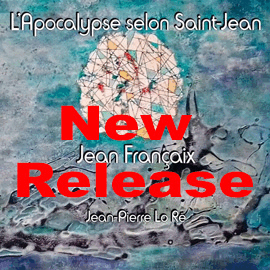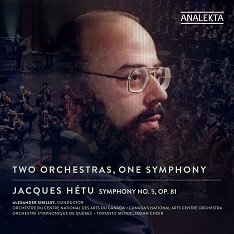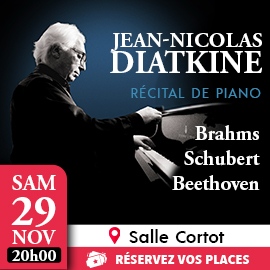Der Kanadier Jacques Hétu (1938-2010), ein Schüler von Henri Dutilleux und Olivier Messiaen, hat seine 5. Symphonie im Auftrag des Toronto Symphony Orchestra komponiert, mit einem letzten Satz, in dem der Chor einen Text von Paul Éluard (1895-1952) singt. Hétu starb drei Wochen vor der Uraufführung der Symphonie im Jahr 2010.
Es ist ein rund 45-minütiges Werk, das programmatisch von der französischen Hauptstadt im 2. Weltkrieg handelt. Die vier Sätze tragen die Titel Prolog (Paris vor dem Zweiten Weltkrieg), Die Invasion, Die Besatzung, und Freiheit.
Der erste Satz ist leicht und voller flirrender Farben. Darauf folgt ein dramatisches, aufgewühltes Vivace. Das Adagio (Die Besatzung) ist düster und bedrückend, und wie die beiden ersten Sätze sehr tonmalerisch und evokativ
Dann folgte das Chorfinale mit dem Text von Éluard, der während des Zweiten Weltkriegs am französischen Widerstand (Résistance) teilnahm und zu dessen Unterstützung viele darauf bezogene Gedichte schrieb. Sein Gedicht Liberté, das von Hétu vertont wurde, war ein wichtiger Appell an das französische Volk: Im Jahr 1942 wurden Kopien von der RAF über ganz Frankreich abgeworfen.
Während die drei ersten Sätze u.a. an die Musik von Shostakovich erinnern, ist der letzte Satz ganz klar französisch gefärbt. Es ist ein Andante, das insgesamt etwas pathetisch wirkt und mit 20 Minuten vielleicht etwas lang ist für das darin verwendete Material. Aber auch Eluards Gedicht ist nicht frei von Pathos, und es ist ebenfalls sehr lang und etwas repetitiv. Daraus ergibt sich für mein Empfinden, dass es diesem letzten Satz etwas an Dramatik und auch an Freude und Aufbruchsgedanken mangelt. Manchmal hat man eher den Eindruck, die Musik berichte von dem Hund, der seine Wunden leckt.
Die Aufführung durch die beiden Orchester und den Mendelssohn-Chor unter Alexander Shelley ist tadellos, und die Tonaufnahme ist ebenfalls gut.
The Canadian Jacques Hétu (1938-2010), a student of Henri Dutilleux and Olivier Messiaen, composed his 5th Symphony on commission from the Toronto Symphony Orchestra, with a final movement in which the choir sings a text by Paul Éluard (1895-1952). Hétu died three weeks before the premiere of the symphony in 2010.
It is a 45-minute work that deals programmatically with the French capital during the Second World War. The four movements are entitled Prologue (Paris before the Second World War), The Invasion, The Occupation and Liberty.
The first movement is light and full of shimmering colors. It is followed by a dramatic, agitated Vivace. The Adagio (The Occupation) is somber and oppressive and, like the first two movements, very tonal and evocative.
This is followed by the choral finale with text by Éluard, who participated in the French Resistance during World War II and wrote many poems in support of it. His poem Liberté, set to music by Hétu, was an important appeal to the French people. In 1942, copies were dropped by the RAF all over France.
While the first three movements recall the music of Shostakovich and others, the last movement is distinctly French. It is an Andante that seems somewhat pathetic overall and, at 20 minutes, is perhaps a bit long for the material it uses. But Eluard’s poem is not free of pathos either, and it is also very long and somewhat repetitive. As a result, I feel that this last movement lacks drama, as well as joy and a sense of optimism. At times, one gets the impression that the music is more like a dog licking its wounds.
The performance by the two orchestras and the Mendelssohn Choir under Alexander Shelley is impeccable, and the recording is good.





















